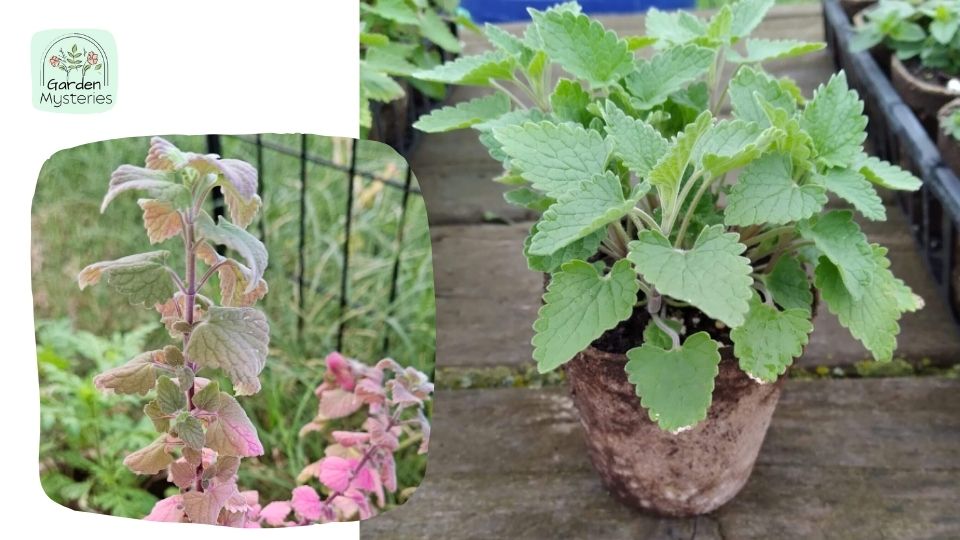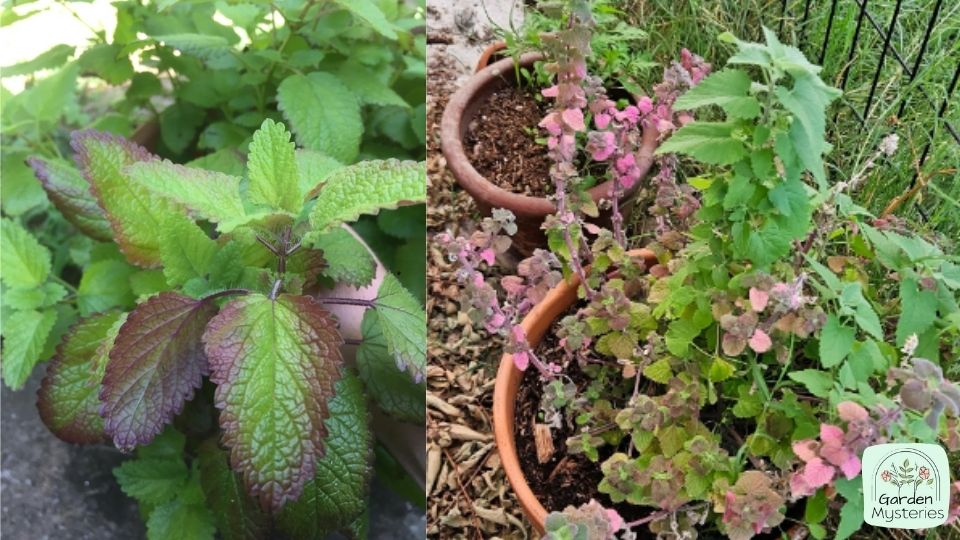I was very happy with the fresh green leaves of my catnip until I saw my catnip growing purple leaves. I didn’t know whether it’s a problem or it’s natural. So, I asked an expert from a nearby nursery about it. She told me that it wasn’t a good sign.
This might happen because of high temperature, lack of nutrients, inadequate light, genetic reasons, etc. If you are having the same issue with your catnip, then this article on catnip purple leaves will help you with everything you need to know. Just keep reading.
Is It a Problem to Have Purple Leave on Cantip?
Having purple leaves on catnip (Nepeta) is not necessarily a severe issue, but it could indicate underlying stress. Several factors can cause this catnip purple leaves color change, including temperature fluctuations, nutrient deficiencies, low light, genetics, or pest/disease stress.
While purple leaves themselves might not be harmful, they often signal that your catnip plant requires adjustments in its care routine. Monitoring the plant’s overall health and addressing the root causes of stress is crucial.
Ensure suitable temperatures, provide adequate nutrients, offer proper lighting, and inspect for pests or diseases. By addressing these factors, you can encourage healthier growth and potentially reduce the purple coloration.
While not a critical problem, understanding and responding to these signs can contribute to the longevity of your catnip plant.
Cause & Solutions: At a Glance
Here’s a concise table summarizing the causes of purple leaves on catnip and their corresponding solutions:
| Cause | Solutions |
| Temperature stress | Protect from cold, provide consistent temperatures, and consider indoor placement during cold spells. |
| Nutrient deficiency | Introduce balanced fertilizer and add humus with composted manure to enrich the soil. |
| Insufficient light | Provide at least 6 hours of sunlight or use appropriate artificial lighting. |
| Genetics | If because of genetics, focus on overall plant health and care. |
| Poor soil drainage | Use well-draining soil mixed with potting soil and perlite. |
| Isolate-affected plants (optional) | Temporarily isolate plants with purple leaves to prevent the potential spread of stress factors. |
| Pruning and trimming | Trim regularly to encourage bushier growth and redirect energy. |
| Proper watering | Maintain consistent moisture and allow the top inch of soil to dry before watering. |
| Patience and observation | Observe the plant’s response to adjustments over time. |
Sometimes, we notice our orchid stems are changing into a pink color. You can have a look at this article for a solution.
What Causes Catnip Leaves to Turn Purple?
Noticing your catnip leaves turning purple? You’re not alone. Several factors can cause this color change, and it’s often a signal that something’s off in the growing environment.
Temperature Stress
Purple or reddish hues often appear after cold nights. Catnip exposed to sudden drops in temperature, especially below 50°F, may produce anthocyanins, a pigment that turns leaves purple.
Nutrient Deficiency
Phosphorus deficiency is a known reason for discoloration in herbs like catnip. If the plant isn’t getting enough nutrients, especially during early growth, leaves may develop a purplish tint.
Insufficient Light or Too Much Sun
Catnip loves sunlight, but too much exposure, particularly if the plant isn’t used to it, can trigger stress pigments. Conversely, too little light can weaken foliage and change its color.
Poor Soil Drainage
Overwatering or compacted soil can lead to root stress, which may cause purple or limp leaves. Poor drainage prevents oxygen from reaching the roots and affects nutrient uptake.
Genetic Factors
Some catnip varieties naturally produce purple-tinted leaves. Cultivars like Citriodora may display purpling as part of their genetic traits rather than as a problem.
What to Do If My Catnip Grows Purple Leaves
If your catnip is growing purple leaves, there are several steps you can take to address the issue and promote healthier growth:
Step 1: Check Environmental Conditions
Ensure that your catnip is in an appropriate environment. Provide sufficient sunlight, at least 6 hours a day, to prevent the plant from producing excessive anthocyanin pigments that cause purple coloration.
Temperature Management: Protect your catnip from temperature fluctuations, especially cold spells. Bring the plant indoors during colder periods to prevent stress that can lead to purple leaves.
Step 2: Nutrient Balance
Check the soil for nutrient deficiencies, particularly phosphorus. Introduce balanced fertilizer to provide essential nutrients and address potential deficiencies. Adding humus with composted manure can enrich the soil and improve overall catnip plant health.
Step 3: Soil Drainage
Ensure the soil has good drainage to prevent waterlogging. A mix of potting soil and perlite can help improve drainage and prevent root rot.
Step 4: Isolation
If you notice specific catnip plants with purple leaves, consider isolating them temporarily from the healthier ones. This can help prevent any potential spread of stress factors like pests or diseases.
Step 5: Pest and Disease Inspection
Regularly examine the plant for signs of pests or diseases. If you find any issues like catnip turning purple, take immediate action to address them and reduce stress on the plant.
Step 6: Pruning and Trimming
Trim the plant regularly to encourage bushier growth and redistribute energy toward healthier leaves.
Step 7: Monitor Watering
Keep the soil consistently moist but not overly wet. Understand how often to water catnip plant. You should let the top inch of soil dry before watering again.
Step 8: Genetic Variation
If the catnip turning purple because of genetics, there might be limited solutions. Focus on ensuring optimal care to maintain the overall health of the plant.
Step 9: Patience and Observation
Sometimes, slight color changes might not be a cause for immediate concern. Observe how the plant responds to adjustments in care over time.
By following these steps, including adding humus with composted manure and potentially isolating affected plants, you can address the issue of purple leaves and encourage your catnip to thrive with healthier foliage.
Is It Normal for Catnip to Have Purple Leaves?
If your catnip is turning purple, you might wonder if it’s something to worry about. In some cases, it’s completely normal, especially depending on the variety you’re growing and the current weather.
Certain catnip cultivars, such as Nepeta cataria ‘Citriodora’, naturally display purple hues in their leaves and stems. This isn’t a problem, it’s simply part of the plant’s genetics. If your plant has always shown a touch of purple, chances are it’s nothing unusual.
However, a sudden color shift from green to purple may signal stress. This can happen due to cooler temperatures, poor light conditions, or nutrient imbalances. For example, exposure to chilly nights or a lack of phosphorus in the soil can trigger a reddish or purple tone.
Sometimes, environmental stressors like overwatering or too much sun can also lead to color changes. When purple leaves appear alongside drooping or stunted growth, that’s a clue the plant may be struggling.
So, is it normal? It depends. If your catnip has always had purple tinges or you’re growing a variety known for it, it’s likely fine. But if the change is sudden and your plant looks unhealthy, it’s worth looking into the growing conditions.
How to Take Care of Catnip?
Taking care of catnip (Nepeta) involves providing the right conditions for its growth and health. You surely don’t want to see catnip turning purple. Here’s a comprehensive guide on how to care for catnip:
Light
- Catnip thrives in full sun. Ensure it receives at least 6 hours of direct sunlight daily.
- If growing indoors, place it near a sunny window or under grow lights.
Soil
- Use well-draining soil to prevent waterlogging, this is good for catnip seeds.
- A mix of potting soil and perlite or sand works well.
Watering
- Keep the soil consistently moist, but avoid overwatering.
- Let the top inch of soil dry out before watering again.
- Water at the base of the plant to avoid wetting the foliage.
Fertilization
- Use a balanced, slow-release fertilizer during the growing season (spring and summer).
- Avoid over-fertilizing, as it can lead to excessive growth with less aromatic oils.
Pruning
- Regularly trim the plant to promote bushier growth and prevent legginess.
- Pinching off catnip flower buds before they fully develop can encourage more foliage growth.
Pests and Diseases
- Regularly inspect for pests like aphids or spider mites and signs of diseases.
- Use natural remedies or insecticidal soap if pests are present.
Harvesting
- Harvest leaves when they’re at their most aromatic, just before the plant catnip flowers.
- You can dry the leaves for your cat’s enjoyment or for herbal teas.
Propagating
- Catnip can be propagated from catnip seeds, cuttings, or by dividing mature plants.
- Sow catnip seeds indoors before the last frost or directly in the garden when the soil warms up.
Container Care
- If growing in pots, choose a container with good drainage and adequate size for root growth.
- Consider repotting every year or two to refresh the soil.
Indoor Winter Care
- If growing outdoors, consider bringing the plant indoors before the first frost.
- Place it near a sunny window and continue regular care.
Cats and Catnip
- Not all cats are affected by catnip, but those that are might enjoy rolling in it or chewing on the leaves.
- Your should let your cat have some supervised playtime with catnip to prevent overconsumption.
Genetic Variability
- Catnip plants can vary in appearance, including leaf color and size, because of genetics.
- Provide optimal care regardless of variations catmint vs catnip to ensure overall health.
By following these care guidelines, you can maintain healthy and thriving catnip plants that your cat will love and that you can enjoy as well.
FAQs
Can I use catnip with purple leaves for my cat?
Yes, catnip with purple leaves is safe for cats. The color change doesn’t affect its appeal to cats, as they’re attracted to the aromatic oils produced by the plant.
Should I be concerned if my catnip has purple stems too?
Purple stems in catnip can also be a result of genetics or stress factors. While not a major concern, it’s important to ensure the plant’s overall health by addressing any underlying issues.
Can I still use purple-leafed catnip for teas or crafts?
Absolutely! Purple leaves are safe and can be used just like green leaves. They retain the same aromatic and flavor properties, making them suitable for making teas or using them in various crafts.
Can you spare 5 minutes? Here’s another article about red leaves on jewel orchids.









